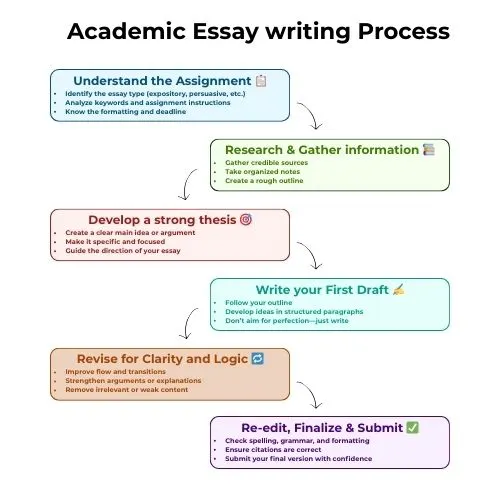UNDERSTANDING THE DIFFERENT TYPES OF ACADEMIC ESSAY
UNDERSTANDING THE DIFFERENT TYPES OF ACADEMIC ESSAY
- Home
- Academy
- Academic Essay
Academic Essay

Recent Post
Introduction
AI and ML have Academic writing is a process that must be acquired by students to effectively present arguments, research, and ideas. The essay is the basic mode of academic writing, but students are scared by the different modes that they must learn. We are going to address here the four broad modes of academic essays—expository, persuasive, analytical, and descriptive—using real-life examples and a simple comparison table to lead you to feel at ease and prepared[1].
Overview of Essay Types

Let’s start with a simple table that compares the main features of each essay type:
Essay Type | Purpose | Key Features | Example Topic |
Expository | Explain a topic clearly and objectively | Factual, logical structure, no personal opinions | Explain the causes of climate change |
Persuasive | Convince the reader to accept a viewpoint | Arguments, emotional appeal, counterarguments | Argue why renewable energy is essential |
Analytical | Break down and examine components of a topic | Critical analysis, interpretation, evidence-based | Analyse character development in “Hamlet” |
Descriptive | Create vivid imagery through detailed descriptions | Sensory language, emotional connection | Describe a historic castle visit |
Expository Essays
Expository essays are concerned with the presentation of clear, factual descriptions of a problem. They aim to inform or explain without incorporating personal opinions. As identified by the University of New South Wales (2023), expository writing is concerned with clarity, logical structure, and evidence-based description[2].
Example: If you were given “The Impact of Plastic Pollution” as an assignment, you would look up facts, consult science research, and tell the public the environmental effect of plastic with statistics without determining whether you think it’s good or bad[2][3]. |
| TIP: Structure your explanatory essay on a thesis statement, body paragraphs, and concise conclusion. |
Persuasive Essays
Argumentative essays (or persuasive essays) are meant to convince readers to a specific point. Persuasive essays, as opposed to expository writing, appeal to readers’ emotions and logic more[4].
Example: In “Why the UK Should Ban Single-Use Plastics,” you would argue your point passionately with evidence of environmental catastrophe statistics, heartbreaking personal stories of animals injured by pollution, and answered counterarguments with compassion. Persuasive writing, in the view of Cambridge Dictionary (2023), must use soundly reasoned arguments, backed by evidence and example, and withstand counterarguments [5]. |
| TIP: State and disprove counterarguments always in order to strengthen your argument. |
Analytical Essays
Analytical essays go beyond description and subject topics to thoroughly think through and break down topics into parts to analyze their meaning and relationships[6].
Example:
Writing on Shakespeare’s “Hamlet,” for instance, you might write about how Hamlet’s thinking reveals broader issues of revenge and ethical doubt, with textual quotes and academic support.
As Scribbr (2023) encourages, great analysis essays make an argument for an interpretation backed up by textual evidence, not Summary.
| TIP: Utilize evidence strategically, explaining how specific areas contribute to your interpretation. |
Descriptive Essays
| TIP: Take all five senses—sight, sound, smell, touch, and taste—along with you |
Practical Application: Case Example
Let’s apply everything to a single topic: “Social Media’s Impact on Society.”
| Essay Type | Example Approach |
| Expository | Explain the history, advantages, and disadvantages of social media without taking a side |
| Persuasive | Argue that social media harms mental health and back up your points with evidence |
| Analytical | Analyse how Instagram’s algorithm shapes users’ self-esteem and social behaviour |
| Descriptive | Describe the buzzing atmosphere at a social media marketing conference |
Seeing the same topic from multiple angles highlights how flexible and powerful different essay forms can be when mastering academic communication.
Conclusion
Understanding the different types of essays gives students the courage to handle any assignment given with confidence and accuracy. Regardless of whether one is requested to describe, persuade, analyse, or explain, having the correct procedure and structure is crucial in writing quality academic papers. Understanding each type also means having good critical thinking highly needed in and outside academia.
Practice writing short essays on typical subjects using each format to get your skills sharpened. With the passage of time, applying the right one will become second nature.
The focus of Tutors India is to assist students in every step involved in academic writing, from conceptualizing various essay types to putting the finishing touch on the final draft. Setting up the structure, doing the research, or smoothing out your arguments-their tutors are ready to help you at each step.
